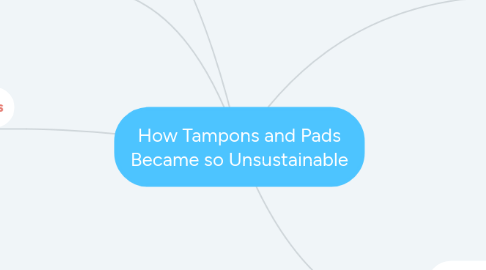
1. Plastic in Pad and Tampons
1.1. This happened because chemistis developed sophisticated plastic and other syntetics
1.1.1. Manufacturers found market in menstrual products.
1.2. The first patent for tampons included a design for a teles coping cardboard tube.
1.2.1. Inventors though that tampons could be inserted more hygienically with an applicator.
1.3. Individual wrapping
1.3.1. Disposable and portable product
2. Packaging for Privacy
2.1. The big companies launched a special offer for their customers.
2.1.1. Discreet purchase
2.1.2. Use
2.1.3. Disposal options
3. The Future of Plactic
3.1. Alternatives
3.1.1. -Menstrual cups
3.1.2. Reusable products
3.1.3. Choose tampons without applicators and made from natural fibers.
4. The Plastic Period Problem
4.1. Menstrual products
4.1.1. Tampons
4.1.1.1. Wrapped in plastic
4.1.1.2. Encased in plastic applicator
4.1.1.3. It has a plastic string dangling
4.1.1.4. It has a thin layer of plastic in the absorbent part.
4.1.2. Pads
4.1.2.1. It has plastic in the leak-proof base that soak up fluid to the packaging
4.2. Menstruation
4.2.1. Women menstruate for about 40 years
4.2.2. They used many pads and tampons
4.2.2.1. Those products end up the trash
4.2.2.2. Tampons flushed down the toilet can end up in the ocean when sewer systems fail.
4.3. Recycling
4.3.1. Although plastic applicators are recyclable, they are usually not accepted for sanitary reasons.
5. History of Menstrual Management
5.1. Period Blood
5.1.1. was seen as something insolubrios and perceived as "bad blood.
5.1.2. Elements used
5.1.2.1. Leftover scraps of fabric
5.1.2.2. Soft strip of bark
5.1.2.3. Or whatever else was available and absorbent.
5.2. 1921: pack of kotex (pads)
5.2.1. Began the era of disposable menstrual product
5.3. 1930: Tampons
5.3.1. were not too different than the ones on drugstore shelves today
5.3.2. made of a wad of dense cotton or a paper-like material attached to a string.
